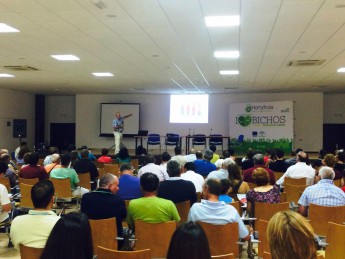 The last day I Love Critters Hortyfruta has analyzed the current situation of the sector and developments in issues such as Tuta absoluta.
The last day I Love Critters Hortyfruta has analyzed the current situation of the sector and developments in issues such as Tuta absoluta.
The Fruit and Vegetable Interprofessional Andalusia (Hortyfruta) He has celebrated a new technical conference in its campaign Biological Control "I Love Bichos, Our Green Revolution”.
The Exhibition and Congress Campohermoso gathered last 3 July a hundred farmers and technicians around the debate on the victories and challenges remaining in tomato and cucurbits.
The talk has the grant from the European Union and the Government of Andalusia, through the Ministry of Agriculture and Fisheries, by the European Agricultural Fund for Rural Development (EAFRD).
Jan van der Blom, doctor entomólogo, head of the Department of Technical Production COEXPHAL, He focused its initial intervention in the main crop in the area of Nijar, the tomato, and in some of its major scourges, as is the whitefly.
The biologist spoke of the revolution caused in the area incorporating Nesidiocoris, "Applied from the seedbed, so the seedling reaches the eggs and this chinche, so soon a population is achieved to control the fly banking ".
Tuta absoluta was another of the problems mentioned at the conference. "Nesidiocoris works but remains problematic in seasons like spring and summer". In this sense, He spoke of a parasitoid (avispilla) "It coming from outside and that has contributed significantly to control Tuta, as the detected sheet and paralyzes ".
The area of Nijar, Van der Blom explains "is a good example of farms that found high levels of parasitism, which implies a biological control almost spontaneously ".
Another pest that was discussed was the Vasates (Aculops lycopersici) tomato. It is a very small mite (no visible a simple vista) which comes from Australia and causes severe damage to tomato.
mainly appears in conditions dry autumn and spring.
The propagation culture is performed by transport in plant material, farming tools and the man himself in clothing and footwear.
Manifesting begins with a tan on the stem and leaves that can reach even the fruits, always from the basal part of the plant upward trend. No winter break and attack at any stage of development of tomato.
The larvae penetrate the fruits, on the leaves or stems of feeding, creating holes and galleries (mines). The mines are irregular and necrotic affecting plant development.
The vasates is a challenge for biological control.
A commercial exhibition representatives of specialized companies joined in supply Biological Control and these were some of their contributions:
Jose Maldonado (AgroBio, S.L.)
"Regarding the tomato crop, the implementation of Nesidiocoris began to perform in field, plants reservoir and then, then we conclude that the best was his release from the seedbed. So the installation goes ahead and have a good population in the repertoires ".
Antonio Robledo (Biobest Biological Systems, S.L.)
"The novelty presented this year on cucurbits is the Nutrimite, a dietary supplement in the form of pollen that Thypha, along with loose Swirsski used cucumber, cantaloupe, watermelon and even pepper. In the area of Nijar we know that organic farming is increasing and there is the problem of aphids. We will expand and complement the catalog of natural enemies of the aphid with marketing Sphaerophoria ".
Sergio Bautista (Biocolor, S.L.)
"Talk of Biological Control in tomato is talk of Nesidiocoris. We all know the full benefits and risks of over-population. It will help in controlling Tuta, fly and aphid. The key is to find suitable moments loose in order to ensure maximum hatching eggs in the seedbed ".
Baltasar Pérez (Koppert España, S.L.)
"The area is eminently Nijar tomatera. It is very important to specify the treatment, Nesidiocoris particularize dose according to each case (trips, Moscow, all). Transplant date, planting density, the type of tomato ... ask all that information and recommend a dose of loose to apply. Care must be taken with care the factors to be around the cultivation. The main challenge is the control of Tuta in spring. Nesidiocoris cycle varies greatly depending on the average temperature of the gases ".
At the technical conference they attended as experts to pass on their experience in Biological Control: Esther Molina (producing tomato), Gabriel Maldonado (producer zucchini), Marco Bruscolotti (Almost technician S.C.A.) and Emilio Pérez (técnico de Coprohníjar S.C.A.)
As general conclusions, They agreed that the implementation of the Biological Control provides "much more vigorous plants, greater security for us -farmers ". Despite "he was a challenge to be a new culture technique, also was a great advantage to the waste problem. It is a balance between what is good for the farmer and what is positive for the consumer ", in the words of Esther Molina.
"The integrated production in Almeria is a totally credible and auditable system, that bears fruit quality, It is respectful of workers and the environment ", said Emilio Perez.
Among the current limitations of Biological Control in the area, in the debate came to light the problem of Vasate in tomatoes, for claiming an effective solution, or specific pest problems in crops such as zucchini, where Nesidiocoris and Swirskii are not enough.
Gabriel Maldonado, producer zucchini, He gave a very telling statistic in relation to New Delhi virus "I opted for the Biological Control and has worked very well; much better than chemical ".
Regarding spring crops, melon and watermelon, because they are short crops, with very fast cycles, technicians and farmers lamented that one of the complaints is that "come not installed auxiliary insects.
Nijar area is a closed circle of production throughout the year. cycles bugs are not cut; not a biological strike is because commercial interests prevail, which it is logical. cycles overlap, so we believe that we must deepen cleaning ", they concluded.
At the close of the talk enlivened by a Spanish wine promotional campaign material he poured I Love Bugs, our green revolution, with the collaboration of Agrobío, Biobest, Biocolor, Cajamar, Koppert y Syngenta.

